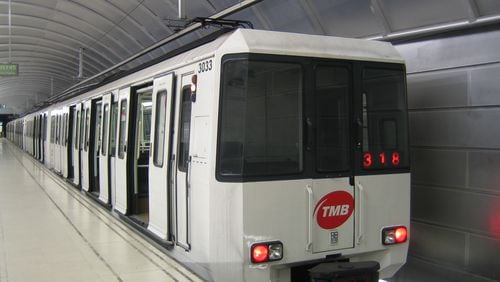My family travels abroad at least once a year and doing so easily conjures up the brain drain of “Back home, this would never be successful,” or “They are just so (insert the positive adjective) here.” The truth is that if we added up the pros and cons of the USA or Atlanta and compared them to any place we have been, our opinions would show far more nuance. That said, the commuting options and habits in both Madrid and Barcelona, Spain recently taught us quite a bit.
First, there are multiple transit options. Madrid and Barcelona both have extensive entanglements of metro train lines and the trains run like tops. In the heart of Downtown Barcelona, for example, trains arrive every two or three minutes during the day and they are often packed. We never rode an empty metro car in either city. And there are substantial reasons for that.
Walking and taking train and bus are not only necessities, but they are cultural in these densely- populated cities. The roads still have plenty of traffic, but they definitely could not handle the majority of the city’s residents taking their cars individually from place to place, like we do in Atlanta. There also is no need for that.
In Barcelona especially, each neighborhood has its own — almost everything. We stayed on a small street, Carre d’Asturies, that has at least three fresh veggie markets, clothing stores, several restaurants and cafes, a pharmacy, at least two gelato stands, and some more specialty shops. The residents live above and around all of this bustle and the Fontana Metro stop sits at the end of the street. The only thing missing is a gas station.
And when people in the Gracia neighborhood do need to go elsewhere, the Metro is convenient and has very small distances between each stop. This chops walking bouts into manageable distances and the walking keeps many Barcelonans in shape. And vast bus systems in both Barcelona and Madrid fill in the gaps between the Metro lines and stops.
One argument against this model being viable in Atlanta is simply that urban sprawl leaves too much ground for rail to cover. But Spain (like much of Europe) also employs low-cost, mainly above-ground regional trains that connect their suburbs with the Barcelona city center.
Georgia could make use of existing railways for regional trains that are separate from, but connect with MARTA, just as GRTA and Xpress buses operate. Decades ago, a commuter train connected Duluth, Norcross, Doraville, and Atlanta. If regional trains could trim freeway traffic just a bit, Atlanta would have more room to grow.
One thing Atlanta does better than Madrid and Barcelona is flight. Madrid’s airport has terribly long lines and requires walking seemingly the length of Iberia to traverse concourses. Barcelona’s is beautiful, but sequesters an entire concourse (ours, E) from the main shopping and eating area and also has a ridiculous screening process right before boarding flights. Hartsfield-Jackson has its flaws as the world’s busiest airport, but it flushes through the droves fairly efficiently.
No city does commuting perfectly, but Madrid and Barcelona teach plenty about city planning. Closeness of goods (and people), the lack of cars, and the ease of mass transit may just make someone want to delay their trip to those cities’ inefficient airports. Metro Atlanta should take note, as more cities establish themselves, but also should pat itself on the back for its typically smooth aviation hub.






